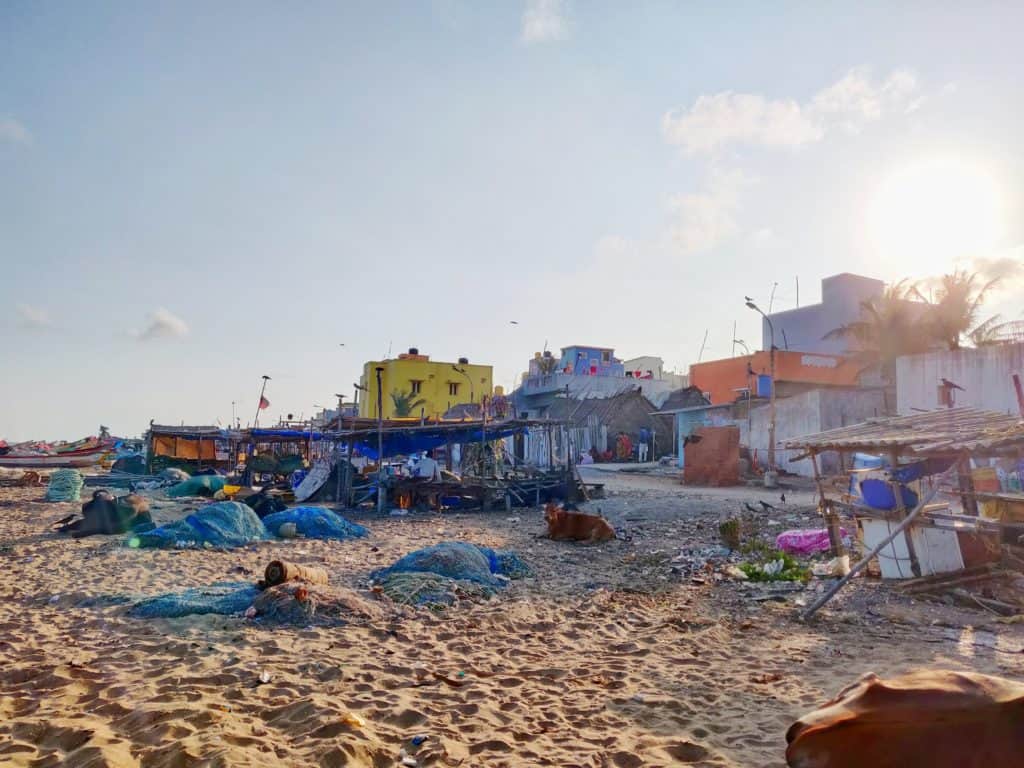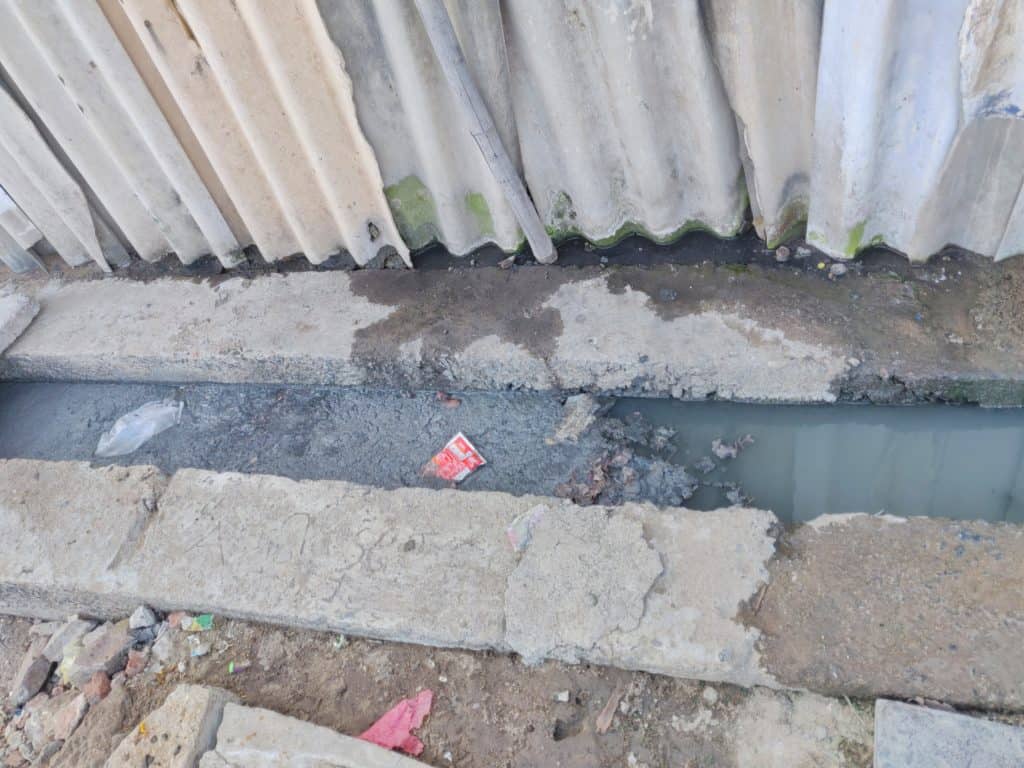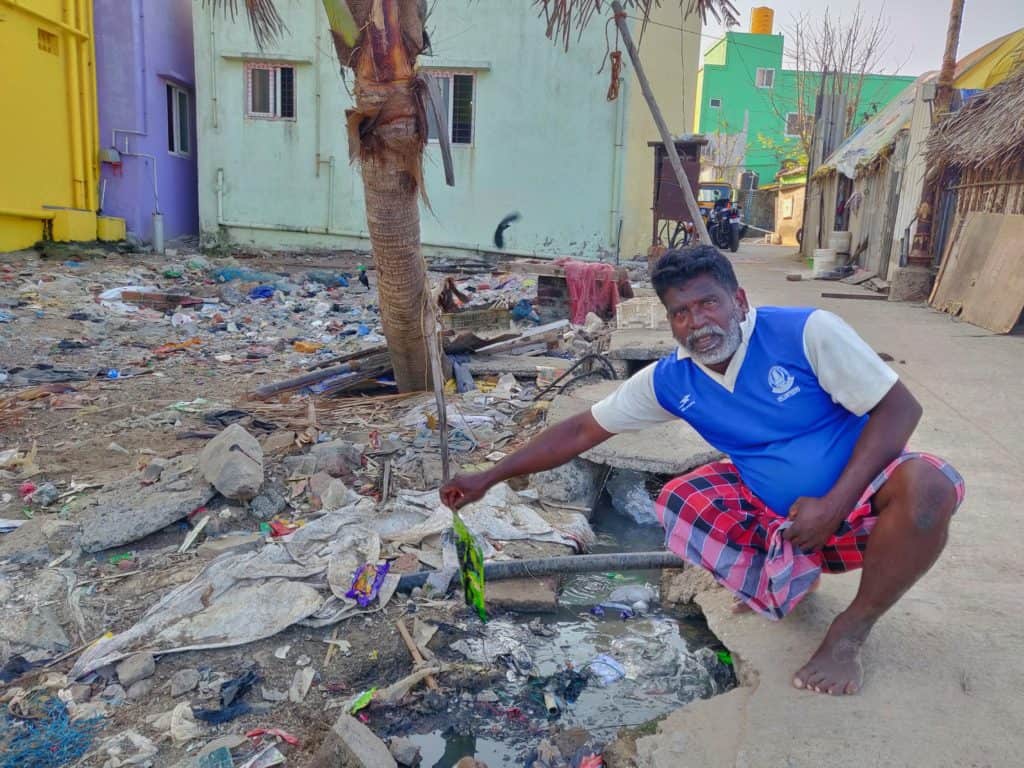As one takes a left turn from the East Coast Road or the ECR, as it’s popularly known in Chennai, into the Kuppam road in Kottivakkam, which leads to the Kottivakkam beach, a sense of calm sets in. A complete contrast from the bustling main road, which is just a few metres away. This sense of calm can also be seen in the residents of the Kottivakkam kuppam (Tamil for hamlet), most of whom you will find unwinding on a weekday evening.
The women folk, after having finished their day’s work of selling fish are huddled in one corner of the road adjacent to the beach on bamboo mats, intent on a game of dice, while the older men form their own groups, playing a game of cards. They wait for their sons to come back from the sea with the catch to be sold the next morning.
Yet this relaxed setting and the apparent picture of joy, bonhomie and contentment belies a persistent problem that they have been facing for years now, something that has become a part of their daily life – open gutters with overflowing sewage water and week-old garbage strewn across the beach and their homes, causing a severe stench and serious health hazards.
“We have been living with this stench for years now, and it has become a part of our lives,” says 41-year-old Selvakumar with a sad smile. The reason for this, as cited by most of the other residents in the village, is the lack of a drainage system, not just in Kottivakkam but also in the other coastal villages along the ECR like Palavakkam, Neelankarai and Uthandi.
Read more: Women of Ennore are living testimony to the many costs of pollution
Problems faced by the residents
Over the years, the residents of the hamlet have had to make their own drainage trench or open gutters outside their homes to let out their semi solid or liquid waste from the kitchen and toilets. These gutters are cleaned only at irregular intervals by the authorities, so that there is a pile up of sewage most of the time. This starts to cause a severe stench and creates a breeding ground for mosquitoes. The situation gets worse during the monsoon, when the sewage water overflows and enters their homes.
The helplessness was stark in the words of 36-year-old Velappan who said that several journalists have come to their village in the past to cover the issue but nothing has come out of it. “Reporters will come, speak to us, get their story and go but we get nothing out of it,” says Velappan, a fisherman whose family has been living in Kottivakkam beach for the past many generations.
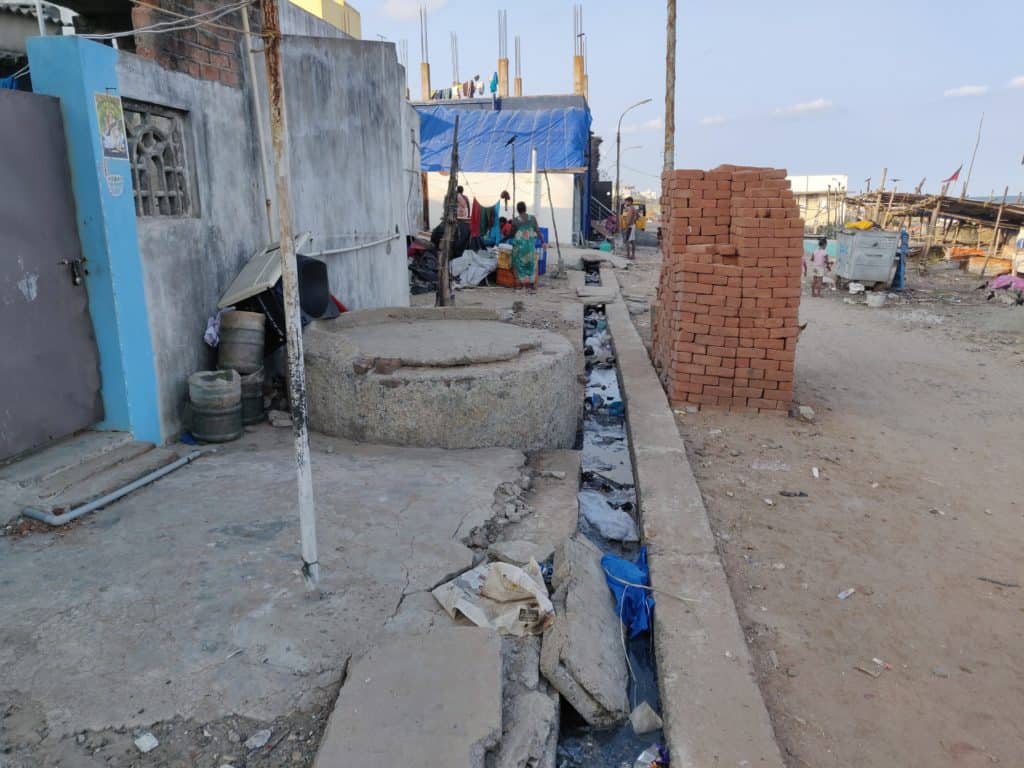
The only way in which citizens have voiced their grievances is by complaining to the workers from the Chennai Metropolitan Water Supply and Sewerage Board (CMWSSB), when they come by to supply water, or to the workers from the Greater Chennai Corporation (GCC) who come once in a couple of months to collect the garbage. It is not known whether these complaints have reached senior authorities at all.
“The only time when authorities even acknowledge our existence is when elections are around the corner. Otherwise nobody bothers to listen to us and we also don’t know whom to complain to?” says 75-year-old Pavanamma. There is a sewage gutter right in front of Pavanamma’s house, which is closed with cement slabs, which is hardly enough as there are still gaps where the sewage flows into their house when it gets full.
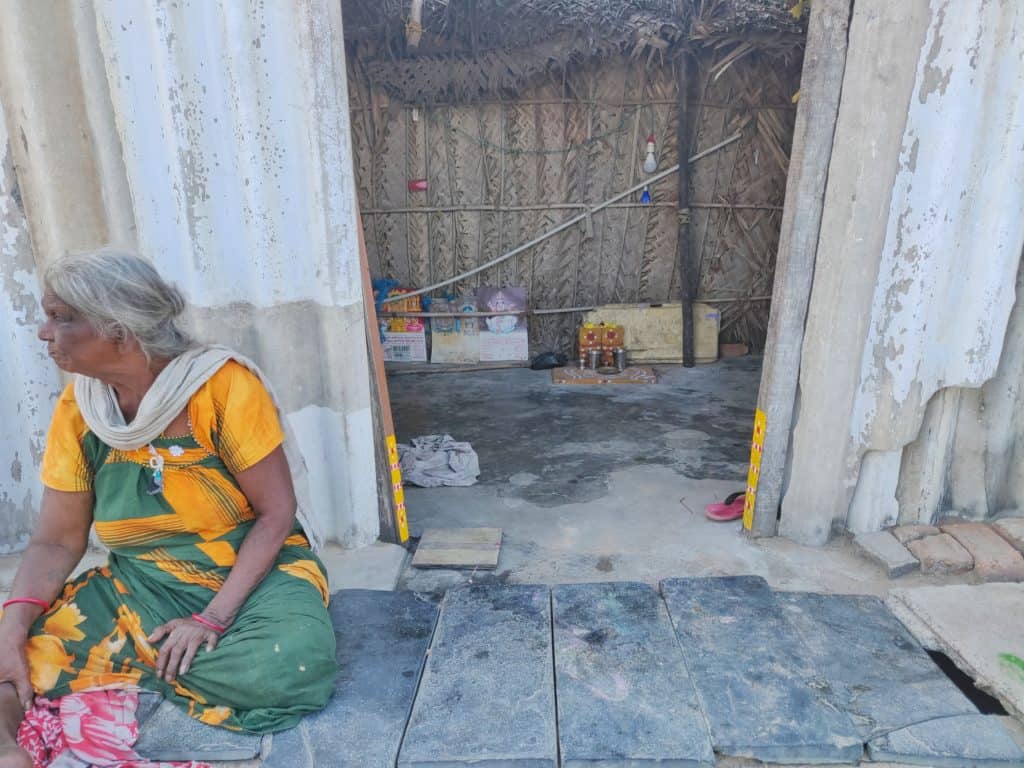
“Usually when our gutters get clogged, we ourselves have to bring a stick or a pole, or sometimes even use our bare hands, to unclog it,” says 40-year-old Omiya. But clogged or not, the houses have no option but to let out their sewage water straight into the beach, which is also where they set up stalls to sell fish, food and other items for the public.
Read more: In Chennai’s resettlement colonies, life comes full circle with the floods
Ecological impact and health hazard
In coastal areas like this, the effects of a lack of proper drainage system can go beyond bad odour and unhygienic living conditions. The impact it can have on the people and the communities nearby are multifold, according to TD Babu, a marine biologist.
- Habitat destruction
As the sewage water from the gutter flows into the beach, the sand has started to erode causing a small pit like structure. “When there is high tide, the waves come deeper into the shores. So, from one side, you have the sea coming into the land, and from the other side, there is the water (sewage water from the open gutters) going into the beach. This accelerates the process of coastal erosion. So when there are storms or heavy tides, there are high chances of a man-made disaster resulting in habitat destruction in the hamlet,” says TD Babu.

Read more: Coastal zone management plan does not follow rulebook; communities feel betrayed
- Health hazards
Most of the activities of the fishing communities and even of those from the non-fishing communities residing nearby take place on the beach. Sometimes, people from other places also visit the beach for recreational activities. People dip their feet in the sea, which is mixed with sewage water from the gutter. This can cause various kinds of skin disease. Children play in the sand which the polluted water flows into, after which they go have food from the nearby stalls without washing their hands. The food from these stalls are also likely to be contaminated, given that toxic water often flows into these stalls and could come into contact with the food, causing diarrhoea and other infections among those who consume it.
- Groundwater pollution
Due to the high permeability of sandy beaches and as a result of the erosion caused due to the high tides and sewage water, the thickness of the sandbed gets reduced, thus polluting the groundwater table. “When a filtering medium becomes thin, it won’t be able to hold on to huge amounts of water and breaks easily,” adds Babu.
‘Govt must take responsibility’
In places like the Foreshore estate, which is another fisher settlement along Chennai’s Marina beach, the Tamil Nadu Slum Clearance Board had constructed several apartment complexes for the fishermen families who used to live in makeshift homes earlier. Because of this, Babu feels that there is a uniformity among the dwelling units in that area and proper systems. But in the fishing hamlets like Kottivakkam kuppam along the ECR, the resident families had themselves constructed the buildings generations ago, in a haphazard manner, which makes it difficult for maintenance.
“Government should come forward and provide proper housing for the fishing communities along the ECR as well, so that it will streamline many issues like sewage disposal, water connection, electricity connection and even garbage clearance,” adds the marine biologist.
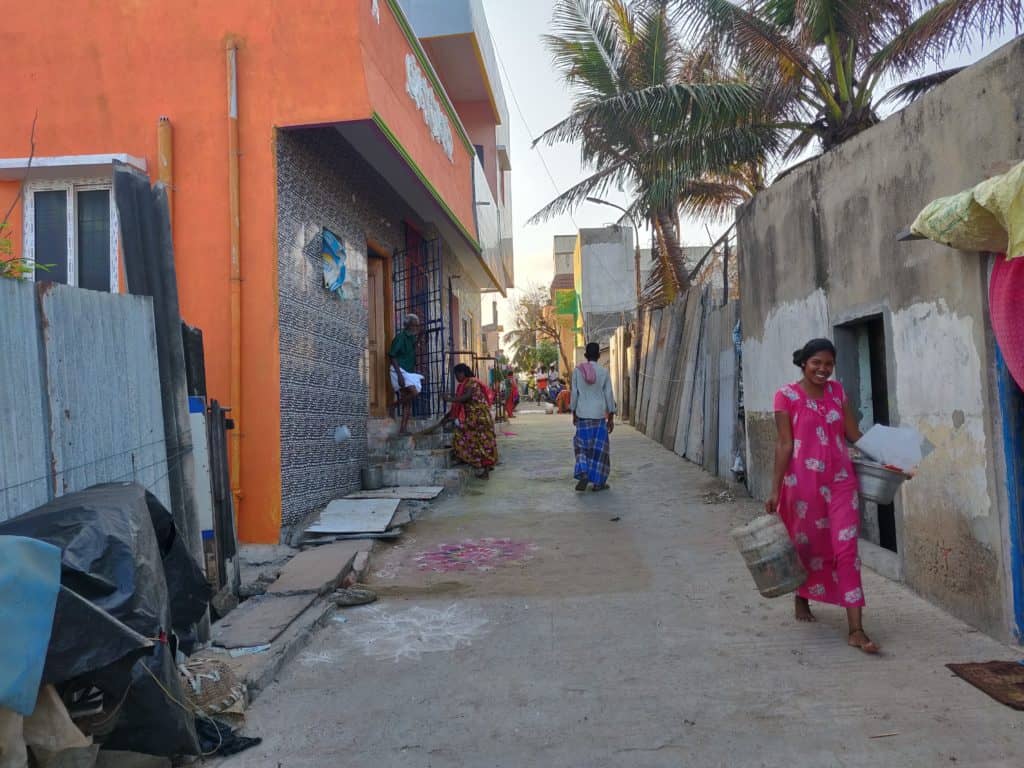
However, KP Kosalaraaman, Zonal President of Sholinganallur (East), Tamil Nadu Congress Committee, says that the successive governments in the state have turned a blind eye towards the fishing hamlets of Kottivakkam, Palavakkam and Uthandi. “When it comes to Kottivakkam, the primary focus of the government is to provide facilities for the comparatively well-off sections of society, which means the socially and economically privileged sections,” says Kosalaraman. He adds that the fishermen of the kuppam are ‘mere statistics’ in the larger list of voters for politicians.
Citizen Matters tried reaching out to officials of the GCC and CMWSSB to find out why the drainage issue has not been solved for years, and what it would take to change the situation. A senior zonal officer from the GCC said that he was unaware about the issue itself and stated that he would study the matter. However, there was no response from CMWSSB.
Demands of the community
According to Kosalaraaman, most of the coastal areas that fall under the GCC, after Thiruvanmiyur towards the ECR road, do not have proper connection to a piped drainage network.
In 2018, during the tenure of the AIADMK government, the Chennai Corporation had started the construction of storm water drains in the coastal areas of Kotivakkam, Palavakakam, Neelankarai and Uthandi. However, following severe opposition from the residents of these coastal areas, the Madras HC in 2020 stayed the construction of the stormwater drains. “From Kottivakkam to Uthandi, around 12 tunnels were constructed for the storm water drains. These were all connected to the sea. But given that there were no separate sewage connections or network, when it rains, the rain water mixed with sewage from the roads would flow through these tunnels into the sea, polluting it. That’s why it was objected to,” says Kosalaraaman.
In December last year, Kosalaraaman, who is also from the fishermen community of Kottivakkam, and various representatives from the coastal areas and members of the Communist party handed over a memorandum to Aravind Ramesh, MLA of Sholinganallur assembly constituency with a list of their demands, which included:
- Sewage lines to be constructed and linked to the drainage network in nearby Thiruvalluvar Nagar.
- Until such a link is established, widening of the existing sewage canals and proper cleaning once a week to maintain hygiene and safety
- All houses must have access to clean water from the Nemmeli desalination plant.
Read more: Nemmeli: Quenching Chennai’s thirst, but at what cost?
Speaking to Citizen Matters, S Aravind Ramesh MLA said that he had discussed the issue with Chief Minister MK Stalin and that funds have been allocated for the purpose of setting up the drainage system. “We are in the tender process now and once the work starts, it will take a minimum of 5 years for it to be completed and ready for use,” he said.
